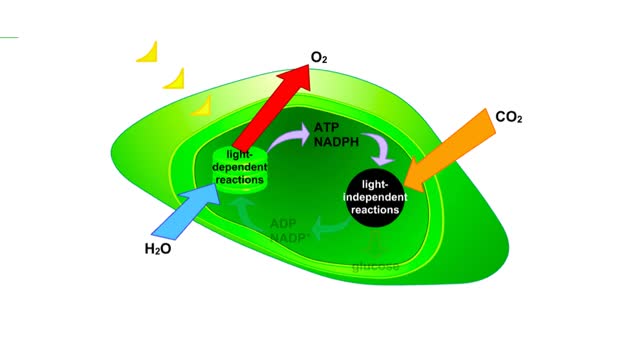Chloroplast Structure & Light Dependent Reactions (Photosystem 1 and 2 Cyclic Electron Flow)
By: HWC
Date Uploaded: 04/07/2020
Tags: homeworkclinic.com Homework Clinic HWC Chloroplast Structure Light Dependent Reactions Chloroplast Structure & Light Dependent Reactions (Photosystem 1 and 2 $ Cyclic Electron Flow photosynthetic palisade mesophyll chloroplasts thylakoids singular granum stroma cyclic electron flow
The leaf is the principle photosynthetic organ of the plant. This is a cross section of a leaf. The rectangular-shaped cells are part of the photosynthetic tissue called the palisade mesophyll. Each photosynthetic cell can contain several hundred organelles known as chloroplasts. The chloroplast is a double-membrane enclosed organelle. The internal membranes, called thylakoids, are organized into stacks called grana (singular granum). The thylakoids are suspended in an aqueous solution called the stroma. All the biochemical reactions of photosynthesis take place in either the stroma or the thylakoids. These reactions are part of the two stages of photosynthesis called: 1) the light-dependent reactions and 2) the light-independent reactions. Complexes of photosynthetic pigments are called photosystems. Plants contain two photosystems: photosystem 1 and photosystem 2. The two photosystems trap light energy which causes electrons from chlorophyll molecules to be excited to a higher energy level. Photosystems 1 and 2 are spatially connected to each other in the thylakoid membrane. Light absorption starts the flow of electrons that result in the generation of ATP and NADPH. You can watch this electron flow by turning on the light switch. Both photosystems work together to harness the energy of electron flow. Light strikes the chlorophyll molecules of photosystem 2 (PS2) and electrons are excited. Their energy is passed from pigment molecule to pigment molecule. Finally, the transferred energy excites a reaction center molecule of chlorophyll a called P680 and electrons are boosted from P680 to a higher energy level. But instead of returning to their more stable ground state, these electrons are captured by an electron acceptor molecule. The P680 molecule in PS2 now is deficient of 4 electrons. It fills this electron hole by capturing 4 electrons from two molecules of water. In the process of taking 4 electrons from water, water is split into 4 protons and one molecule of oxygen gas. The electrons passed from P680 in PS2 are now transferred to an electron transport chain located within the thylakoid membrane. The flow of electrons through this electron transport chain causes protons to be pumped across the thylakoid membrane into the inner thylakoid space where the protons accumulate. Protons diffuse from a region of higher concentration to a region of lower concentration by flowing through an ATP synthase enzyme complex embedded in the thylakoid membrane. Simultaneously with PS2 absorbing photons of light, photosystem 1 (P51) absorbs photons as well. The reaction center molecule of chlorophyll a in PS1, however, absorbs energy in the 700 nm wavelength. The excited electrons from PSI are passed to another electron acceptor molecule, Where they are passed along a different electron transport chain. The electrons complete their transit through the electron transport chain and reduce NADP+ to NADPH. PS1 and PS2 generally work together in harnessing the energy from sunlight to synthesize ATP and NADPH which will be used in the light-independent reactions of photosynthesis. However, sometimes PS1 can be disconnected from PS2 to allow for the generation of additional ATP. This occurs when PS1 electrons do NOT reduce NADP+ but instead are passed to the electron transport chain which connects PS2 and PS1. The flow of electrons down this chain generates proton transport into the thylakoid space. Protons then diffuse through the ATP synthase complex where ATP is synthesized from ADP and inorganic phosphate. The spent electrons are now available to replenish the electron "hole" in the PS1 reaction center molecule. The electrons have now completed a cycle, hence the term "cyclic electron flow."
Add To
You must login to add videos to your playlists.
Advertisement












Comments
0 Comments total
Sign In to post comments.
No comments have been posted for this video yet.